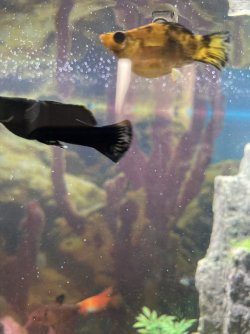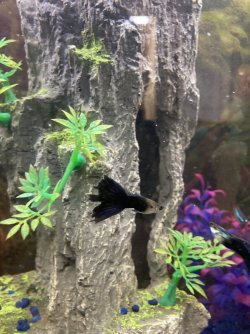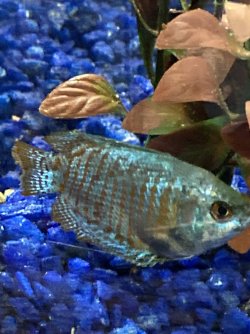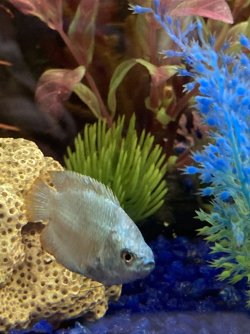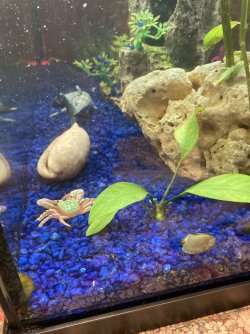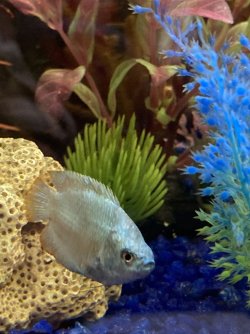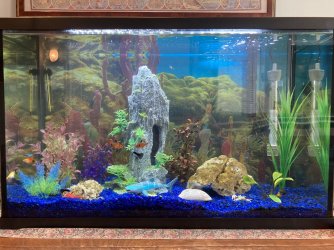I just bought a new green lantern type platy that I just noticed is either being picked on or has some disease. Want to try and fix it. See pic. and how do you manage a fish in a quarantine
 bowl without filter and warmer?
bowl without filter and warmer?
You are using an out of date browser. It may not display this or other websites correctly.
You should upgrade or use an alternative browser.
You should upgrade or use an alternative browser.
My new fish is either sick or being picked on
- Thread starter Sea Aggie
- Start date
The fish has an infection on its back before the dorsal fin. It is either bacterial or external protozoan. A better picture might provide more info.
You can try salt (2-4 heaped tablespoons of salt per 20 litres of water). Keep salt in there for at least 2 weeks.
If there's no improvement after 48 hours you will need a chemical medication or something else.
-------------------
In a small unfiltered container, have an airstone and change all the water every day. Wipe the inside of the container out each day too.
Make sure any new water is free of chlorine/ chloramine before it's added to the tank.
Keep the container off the floor because it will get colder.
You can try salt (2-4 heaped tablespoons of salt per 20 litres of water). Keep salt in there for at least 2 weeks.
If there's no improvement after 48 hours you will need a chemical medication or something else.
-------------------
In a small unfiltered container, have an airstone and change all the water every day. Wipe the inside of the container out each day too.
Make sure any new water is free of chlorine/ chloramine before it's added to the tank.
Keep the container off the floor because it will get colder.
Pretty advanced but moved him last night but he looks too far gone. Don’t think it will make the night. Was worried because noticed he was swimming underneath other fish and shaking. Think he was trying to scratch himself. Felt sorry for it.The fish has an infection on its back before the dorsal fin. It is either bacterial or external protozoan. A better picture might provide more info.
You can try salt (2-4 heaped tablespoons of salt per 20 litres of water). Keep salt in there for at least 2 weeks.
If there's no improvement after 48 hours you will need a chemical medication or something else.
-------------------
In a small unfiltered container, have an airstone and change all the water every day. Wipe the inside of the container out each day too.
Make sure any new water is free of chlorine/ chloramine before it's added to the tank.
Keep the container off the floor because it will get colder.
So my question now is, will this spread to other fish because it’s in the water? Do I do another water change? So far don’t see this in the other fish at the moment.Pretty advanced but moved him last night but he looks too far gone. Don’t think it will make the night. Was worried because noticed he was swimming underneath other fish and shaking. Think he was trying to scratch himself. Felt sorry for it.
It can spread to other fish. You will have to monitor them for a few weeks.
If you do a big water change (75%) and gravel clean the substrate every day for a week, it will dilute any disease organisms in the water and reduce the risk to the other fish. You an go back to weekly water changes after that.
Make sure any new water is free of chlorine/ chloramine before it's added to the tank.
Clean the filter too if it hasn't been done in the last 2 weeks.
Add some salt to the main tank to kill off any remaining pathogens.
If you do a big water change (75%) and gravel clean the substrate every day for a week, it will dilute any disease organisms in the water and reduce the risk to the other fish. You an go back to weekly water changes after that.
Make sure any new water is free of chlorine/ chloramine before it's added to the tank.
Clean the filter too if it hasn't been done in the last 2 weeks.
Add some salt to the main tank to kill off any remaining pathogens.
Thanks. Really paranoid now. I am noticing little things but not sure if the fish always looked like that on their fins or if some have simply been nipped overtime. See pics. Black platy caught my eye.
Did a 75% water change and substrate cleaning. Also added 2 pinches of some sea salt to a 29 gal.
Did a 75% water change and substrate cleaning. Also added 2 pinches of some sea salt to a 29 gal.
Attachments
The black molly looks like it has a creamy white patch on its back before the dorsal (top) fin. This is probably excess mucous or something on the glass.
The black tail guppy has been bitten by someone.
---------------------
SALT
You can add rock salt (often sold as aquarium salt), sea salt or swimming pool salt to the aquarium at the dose rate of 1 heaped tablespoon per 20 litres of water. If there is no improvement after 48 hours you can double that dose rate so there is 2 heaped tablespoons of salt per 20 litres.
If you only have livebearers (guppies, platies, swordtails, mollies), goldfish or rainbowfish in the tank you can double that dose rate, so you would add 2 heaped tablespoons per 20 litres and if there is no improvement after 48 hours, then increase it so there is a total of 4 heaped tablespoons of salt per 20 litres.
Keep the salt level like this for at least 2 weeks but no longer than 4 weeks otherwise kidney damage can occur. Kidney damage is more likely to occur in fish from soft water (tetras, Corydoras, angelfish, Bettas & gouramis, loaches) that are exposed to high levels of salt for an extended period of time, and is not an issue with livebearers, rainbowfish or other salt tolerant species.
The salt will not affect the beneficial filter bacteria but the higher dose rate (4 heaped tablespoons per 20 litres) will affect some plants and some snails. The lower dose rate (1-2 heaped tablespoons per 20 litres) will not affect fish, plants, shrimp or snails.
After you use salt and the fish have recovered, you do a 10% water change each day for a week using only fresh water that has been dechlorinated. Then do a 20% water change each day for a week. Then you can do bigger water changes after that. This dilutes the salt out of the tank slowly so it doesn't harm the fish.
If you do water changes while using salt, you need to treat the new water with salt before adding it to the tank. This will keep the salt level stable in the tank and minimise stress on the fish.
The black tail guppy has been bitten by someone.
---------------------
SALT
You can add rock salt (often sold as aquarium salt), sea salt or swimming pool salt to the aquarium at the dose rate of 1 heaped tablespoon per 20 litres of water. If there is no improvement after 48 hours you can double that dose rate so there is 2 heaped tablespoons of salt per 20 litres.
If you only have livebearers (guppies, platies, swordtails, mollies), goldfish or rainbowfish in the tank you can double that dose rate, so you would add 2 heaped tablespoons per 20 litres and if there is no improvement after 48 hours, then increase it so there is a total of 4 heaped tablespoons of salt per 20 litres.
Keep the salt level like this for at least 2 weeks but no longer than 4 weeks otherwise kidney damage can occur. Kidney damage is more likely to occur in fish from soft water (tetras, Corydoras, angelfish, Bettas & gouramis, loaches) that are exposed to high levels of salt for an extended period of time, and is not an issue with livebearers, rainbowfish or other salt tolerant species.
The salt will not affect the beneficial filter bacteria but the higher dose rate (4 heaped tablespoons per 20 litres) will affect some plants and some snails. The lower dose rate (1-2 heaped tablespoons per 20 litres) will not affect fish, plants, shrimp or snails.
After you use salt and the fish have recovered, you do a 10% water change each day for a week using only fresh water that has been dechlorinated. Then do a 20% water change each day for a week. Then you can do bigger water changes after that. This dilutes the salt out of the tank slowly so it doesn't harm the fish.
If you do water changes while using salt, you need to treat the new water with salt before adding it to the tank. This will keep the salt level stable in the tank and minimise stress on the fish.
Thanks for all the advice. The black one has a bit of gold tips on her top dorsal fin but will check to see if she has spots. It’s the back fins that worry me as they look more transparent but intact. Will watch. The guppies just look like they are being nipped from your comments. Has just recently happened in the last 2-3 weeks.The black molly looks like it has a creamy white patch on its back before the dorsal (top) fin. This is probably excess mucous or something on the glass.
The black tail guppy has been bitten by someone.
---------------------
SALT
You can add rock salt (often sold as aquarium salt), sea salt or swimming pool salt to the aquarium at the dose rate of 1 heaped tablespoon per 20 litres of water. If there is no improvement after 48 hours you can double that dose rate so there is 2 heaped tablespoons of salt per 20 litres.
If you only have livebearers (guppies, platies, swordtails, mollies), goldfish or rainbowfish in the tank you can double that dose rate, so you would add 2 heaped tablespoons per 20 litres and if there is no improvement after 48 hours, then increase it so there is a total of 4 heaped tablespoons of salt per 20 litres.
Keep the salt level like this for at least 2 weeks but no longer than 4 weeks otherwise kidney damage can occur. Kidney damage is more likely to occur in fish from soft water (tetras, Corydoras, angelfish, Bettas & gouramis, loaches) that are exposed to high levels of salt for an extended period of time, and is not an issue with livebearers, rainbowfish or other salt tolerant species.
The salt will not affect the beneficial filter bacteria but the higher dose rate (4 heaped tablespoons per 20 litres) will affect some plants and some snails. The lower dose rate (1-2 heaped tablespoons per 20 litres) will not affect fish, plants, shrimp or snails.
After you use salt and the fish have recovered, you do a 10% water change each day for a week using only fresh water that has been dechlorinated. Then do a 20% water change each day for a week. Then you can do bigger water changes after that. This dilutes the salt out of the tank slowly so it doesn't harm the fish.
If you do water changes while using salt, you need to treat the new water with salt before adding it to the tank. This will keep the salt level stable in the tank and minimise stress on the fish.
I do have a few complications with salt as I do have plants, recently added gouramis, minor and neon tetras, blue and brown snails. So trying to see if I need to invest in a small sick tank now.
I work for a company that sells sea salts for agricultural purposes. Ours naturally contains 90 elements and trace minerals and we are doing some investigation to see if we need to get into the aquarium business. www.SeaAgri.com. I do use our salt very lightly when treating.
Attachments
The red and blue striped gourami has fin rot on its tails. It' also looking skinny and sunken in around the head. This is a male fish.
The plain blue gourami is also a male and the two of them will be fighting over territory.
If you have a real crab in the tank, you are asking for trouble. They are nocturnal scavenger/ predators and will catch and eat fish at night.
The plain blue gourami is also a male and the two of them will be fighting over territory.
If you have a real crab in the tank, you are asking for trouble. They are nocturnal scavenger/ predators and will catch and eat fish at night.
Here is a pick but will look more closely at them since I thought they were fine. Did not think 2 gouramis that were in a smaller 10 gal with 6+ would be an issue. No crab, just some snails.Can you show a picture of the whole tank, they don't look well. Salt as @Colin_T suggests
Attachments
UnknownFishies
Fish Addict
From experience Serpae tetras and Dwarf Gouramis do not go well together as they are both aggressive fish. As others above have said, add salt and monitor the 2 gouramis as they to will fight.
To make the Gourami's happy, I would suggest putting a lot of floating plant on the surface of the tank, about half the tank in floating plants.
Similar threads
- Replies
- 7
- Views
- 404
- Replies
- 20
- Views
- 603
- Replies
- 1
- Views
- 175


